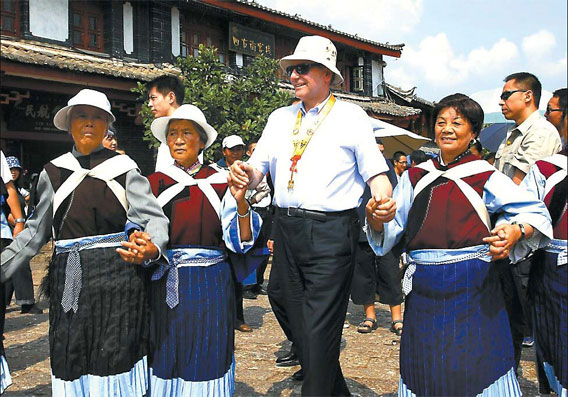Ethnic culture brings ancient city to life
|
International Olympic Committee President Jacques Rogge (center) danced with local Naxi people during a visit to Lijiang in August last year. Zhang Wenyin |
What fascinates tourists from home and abroad about the ancient city of Lijiang? Its ethnic culture offers the answer.
After Lijiang was listed as a World Natural and Cultural Heritage Site in December 1997, the 800-year-old city came back to vigor and vitality.
UNESCO praised Lijiang for its remarkable achievements in protecting the ancient city and held it up as a good example of heritage protection for China and the Asia-Pacific region.
Due to protection and management, Lijiang has promoted the rational development of the tourism industry and the entire local society.
According to the official statistics, in 2007, per capital gross domestic product (GDP) in Lijiang reached 17,000 yuan and the city's fixed-asset investment surpassed 6 billion yuan.
Tertiary industries, with the tourism sector as the mainstay, account for over 50 percent of the GDP, compared with Yunnan province's average of 39.4 percent. Thirteen percent of the residents' income comes from the tourism industry.
Journey of rebirth
But the achievement did not come easily.
The reputation of the ancient city of Lijiang dates back to the late Southern Song Dynasty (1127-1279) when a Mongolian general Kublai Khan, the first emperor of the Yuan Dynasty (1279-1368), occupied the region in 1252 on his way to conquering the Dali Kingdom. Lijiang then became the hub of the ancient tea and horse trading routes linking Sichuan, Yunnan, Tibet and South Asia.
In 1986, architecture professor Zhu Liangwen led 19 teachers and students from an American university to study the buildings of the local Naxi people. Professor Zhu found that some successful local families had begun replacing traditional wooden houses with modern reinforced concrete structures.
The local government also had a plan to develop the economy at the price of leveling a 3.8 sq km ancient residential area in the center of the city.
Zhu immediately wrote the Yunnan provincial government, saying the move would ruin the ancient city.
Fortunately, after reading Zhu's letter and reports of the local construction commission, the provincial government decided to drop the plan.
On February 3, 1996, an earthquake measuring 7 on the Richter scale hit Lijiang, causing the death of 17,366 people and direct economic losses of 4 billion yuan.
When rebuilding the city, the local government then gave priority to protecting the ancient town. Yet whether to remove the original houses and build new ones was subject of heated discussion. An agreement was finally reached to preserve the town as it was before the earthquake.
In repairing the residential facilities, the proposal of "keeping old as old" was adopted.
Professor Zhu, a proponent for the decision, thought that the attraction of the ancient town does not lie in greatness or beauty, but in its simplicity.
Culture's 'roots and seeds'
|
Surrounded by mountains, Lugu Lake is a famed attraction in Lijiang. Zhang Wenyin |
Fei Xiaotong, a renowned Chinese sociologist and anthropologist, put forward a concept of cultural awareness in 1997 that said "history and tradition are roots and seeds for continuing culture".
The process of protecting the ancient city of Lijiang followed that notion.
Lijiang has made a great contribution to protecting ethnic elements, especially the Naxi culture.
The Naxi people are famous throughout the country for their well-preserved ancient folk music and Dongba pictographic characters. Twenty-two performing groups of their ancient musical teams and 14 schools teaching Dongba culture play an active role in preserving the Naxi culture. The most famous Naxi music group was founded by renowned Naxi musician Xuan Ke, praised as a hero for protecting the Chinese ethnic culture.
Naxi ancient music has gained international recognition since due to performances across the world including the United Kingdom, Norway and Finland.
Traditional crafts including wooden art, Dongba wax printing on cloth, Dongba paper, copper vessels and Naxi wall painting continue to be practiced and spread by a number of practitioners.
Beneficial coexistence between nature and humans have enabled the tourism industry in Lijiang to maintain rapid development, yet sustain the momentum in the future.
Jim Thorsell, a senior expert of the International Union for Conservation of Nature, once said, the reason he loves the ancient city of Lijiang most is its combination of cultural and natural heritage - as if the water of life originates from nature in the city.
(China Daily 06/10/2008 page18)
















